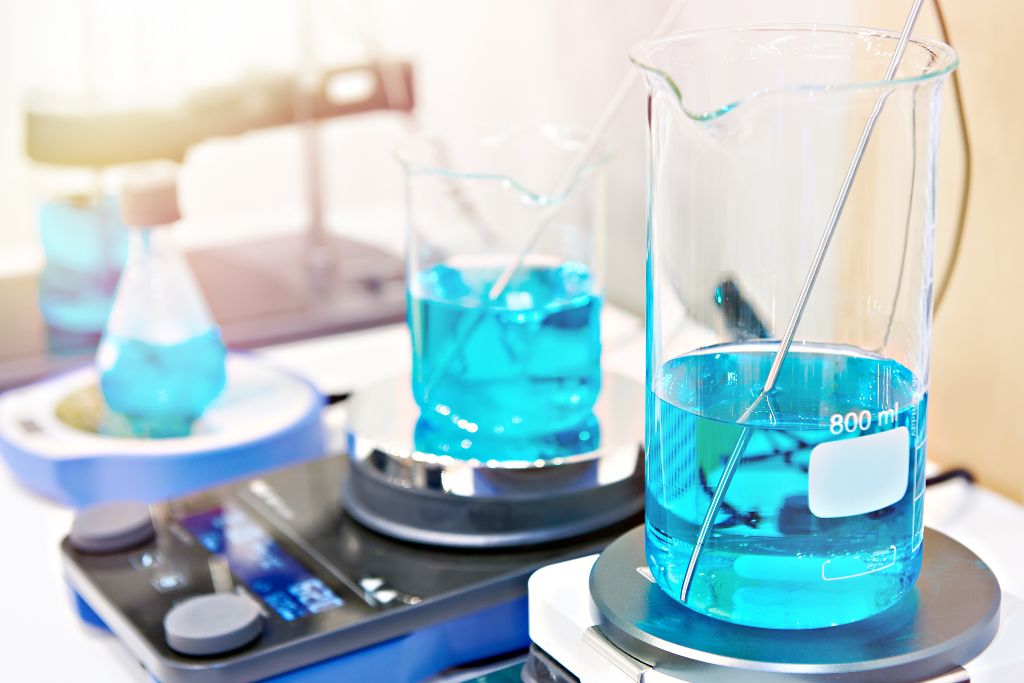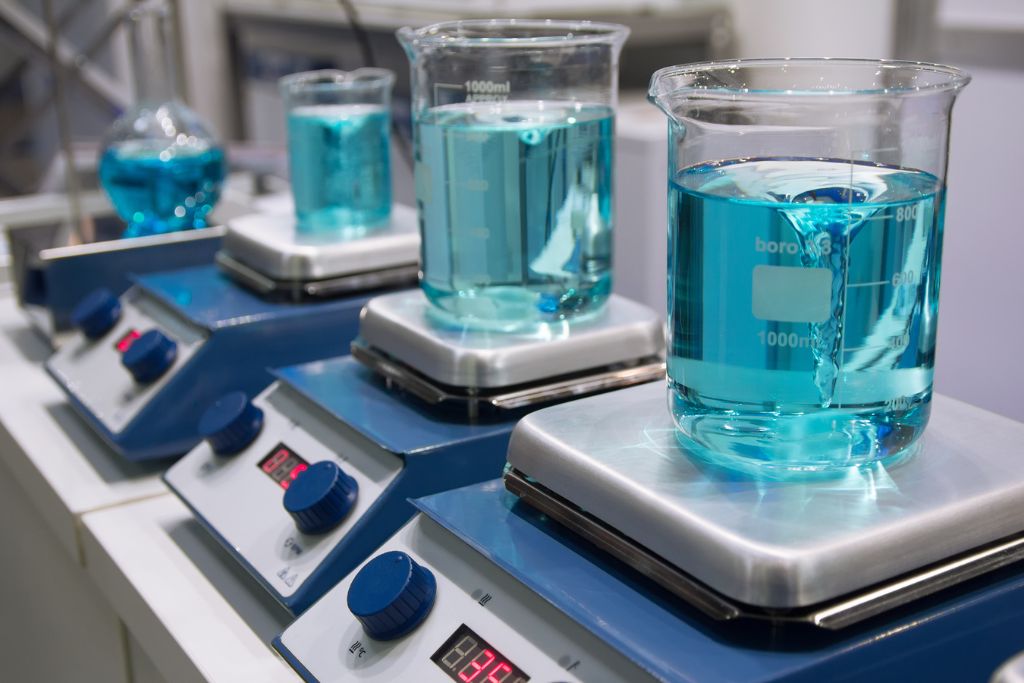A hotplate magnetic stirrer is an essential tool for anyone working in a lab setting or conducting experiments at home. These devices combine heating and stirring capabilities, allowing you to efficiently mix and heat liquids simultaneously. Choosing the right model for your needs can greatly enhance your productivity and accuracy in the lab.
When selecting the best hotplate magnetic stirrer, consider factors like temperature range, stirring speed, and build quality. Understanding these features will help you make an informed decision and ensure you find a model that meets your specific requirements.
Regular maintenance of your stirrer ensures long-term performance and reliability. By choosing a reputable brand and understanding how to care for your equipment, you can achieve consistent results in all your mixing tasks.
Key Takeaways
- A hotplate magnetic stirrer efficiently mixes and heats liquids at the same time.
- Consider key features like temperature control and durability when choosing a model.
- Proper maintenance enhances the lifespan and performance of your stirrer.
Overview of Magnetic Stirrers
Magnetic stirrers are essential tools in laboratories for mixing solutions. They use magnetic forces to create motion, providing an efficient way to blend liquids without manual intervention.

Principles of Operation
Magnetic stirrers work on a simple yet effective principle. The device has a rotating magnetic field created by an electromagnet beneath the stirring surface. When you place a stirring bar inside your liquid, the magnetic field propels it to spin.
For more information, check out our Magnetic Hotplate Stirrer page.
This motion allows the stirring bar to circulate the liquid, ensuring even mixing. Most magnetic stirrers let you adjust the speed of rotation, typically up to 2,500 revolutions per minute (rpm). This gives you flexibility based on the viscosity of the liquid and the required mixing intensity.
Applications in the Laboratory
Magnetic stirrers are used in various laboratory settings, including chemistry, biology, and pharmaceuticals. They are excellent for preparing solutions, mixing reagents, and conducting experiments that require consistent agitation.
Their efficiency makes them ideal for use with sensitive processes where manual stirring could introduce errors or contamination.
In addition, many magnetic stirrers come equipped with heating elements, allowing you to control temperature alongside mixing. This feature is often used for reactions that require heating, making it a valuable tool in any lab setting.
Understand why proper equipment is crucial in our article on the Importance of Laboratory Equipment
Selecting a Hotplate Magnetic Stirrer
When choosing a hotplate magnetic stirrer, consider key features such as temperature range, stirring speed, capacity, size, and material. These aspects will ensure the equipment meets your specific laboratory needs.
If you’re interested in more advanced features, consider our Digital Hotplate Magnetic Stirrer options.
Temperature Range and Control
Temperature range is a crucial feature of hotplate magnetic stirrers. Check if the model can reach the temperatures required for your experiments. Some stirrers have a limited range, while others offer precision control for high or low-temperature applications.
A good stirrer should include an adjustable thermostat for accurate temperature settings. Look for models with digital displays, which can provide real-time updates on temperature. Features such as over-temperature protection are also important for safety.
Stirring Speed and Capacity
Stirring speed directly affects the mixing efficiency. Many hotplate stirrers offer a variable speed option, allowing you to adjust the speed from low to high according to your needs. This flexibility is important for alternating between gentle mixing and vigorous agitation.
Check the capacity of the stirrer as well. This means assessing the volume of liquid it can handle effectively. Some models work well for small samples, while others can stir large volumes, such as 20 liters. Ensure the model you choose matches your experiment’s requirements.
Size and Material Considerations
The size of the hotplate magnetic stirrer is another key factor. Ensure it fits well on your lab bench with enough space for your glassware. Many stirrers come in various sizes to accommodate different needs.
Material quality is essential for durability. Look for hotplates made from robust materials like stainless steel or aluminum. These materials enhance performance and resist corrosion. Also, consider the design, as some stirrers come with spill trays or heat-resistant surfaces for added safety.
Features and Specifications
Understanding the features and specifications of hotplate magnetic stirrers is crucial for selecting the right model. The technology and safety options play vital roles in functionality and user experience.
Digital vs. Analog Interfaces
When choosing a hotplate magnetic stirrer, you’ll encounter two primary types: digital and analog interfaces. Digital models often feature LCD displays that provide real-time information about temperature and stirring speed. This allows for precision in settings and ease of use.
With digital interfaces, you can easily program specific temperatures and stirring times. Many advanced models even include features like temperature probes for accurate readings.
In contrast, analog stirrers typically use knobs for controlling settings. They may be simpler and less expensive, but they lack the precision of digital models. Therefore, consider which type aligns best with your laboratory needs.
Safety Features
Safety is a top priority when working with hotplate magnetic stirrers. Look for features that enhance user protection. For instance, many models come with over-temperature protection that automatically shuts off the device if it exceeds the set temperature.
Another important safety feature is thermal insulation, which prevents heat from transferring to the exterior surfaces, reducing the risk of burns. Models may also include non-slip feet to keep the stirrer stable during use.
Finally, certifications such as CE and RoHS indicate compliance with safety standards. Always verify these features to ensure a safe working environment.
Additional Functionalities
Several additional functionalities can enhance the performance of hotplate magnetic stirrers. Many devices now come with programming capabilities, allowing you to create and save specific protocols. This is especially useful in repetitive experiments.
Some models include remote control options for ease of operation. This feature enables you to adjust settings without being directly at the unit.
Additionally, look for models with integrated heating baths or the capability to add them. This feature permits greater control over sample temperatures. By evaluating these functionalities, you can choose the right stirrer that meets your unique requirements.

Maintenance and Care
Proper maintenance and care of your hotplate magnetic stirrer will enhance its performance and prolong its lifespan. Regular cleaning and troubleshooting minor issues are key steps you can take to ensure smooth operation.
For more tips on equipment care, visit our guide on How to Use a Rotary Evaporator.
Routine Cleaning Procedures
To keep your hotplate magnetic stirrer in good condition, follow these cleaning steps:
- Turn Off and Cool Down: Always turn off the device and let it cool completely before cleaning.
- Use a Soft Cloth: Wipe the surface with a damp cloth. Avoid using harsh chemicals or abrasive cleaners, as these can damage the surface.
- Remove Residues: For stubborn stains, use a soft brush or non-abrasive sponge with mild soap and water. Make sure no liquid enters electrical components.
- Dry Thoroughly: After cleaning, use a dry cloth to wipe the stirrer. Ensure no moisture remains before storing.
- Store Properly: Keep the stirrer in a clean, dry place to prevent dust accumulation.
Troubleshooting Common Issues
Being proactive in addressing common challenges can prevent more significant problems:
- Stir Bar Not Rotating: Ensure the stir bar is the correct size and not too heavy for the stirrer’s capacity. Check for any obstructions beneath the hotplate.
- Heating Issues: If the hotplate isn’t heating, verify the power source. Ensure the device is plugged in properly and the outlet is functional.
- Unusual Noises: Unusual sounds often indicate a problem with the stir bar. Check if the bar is damaged or if it’s making contact with the sides of the container.
- Temperature Fluctuations: If the heating is irregular, check the temperature settings and ensure the hotplate is clean. Residues can affect heat transfer.
By following these maintenance tips, you will ensure optimal performance and longevity for your hotplate magnetic stirrer.
Brands and Manufacturers
When selecting a hotplate magnetic stirrer, it’s essential to consider the brands and manufacturers that dominate the market. Leading brands offer reliability, advanced features, and strong customer support. Warranty and support options can also affect your purchasing decision.
Industry Leaders
Several brands are known for producing high-quality hotplate magnetic stirrers. For instance, Thermo Fisher offers the Cimarec+ and SuperNuova+ series, which are praised for precision and robust performance.
Another industry leader is VWR, known for its Dyla-Dual™ Hot Plate Stirrer. This model provides a combination of durability and ease of use ideal for general lab applications.
Additionally, Remi Lab World provides a variety of models that cater to different laboratory needs, along with their MLH series, known for accurate speed control and stainless steel hot plates.
Warranty and Support Options
Warranty and support can significantly improve your experience. Many manufacturers offer warranties covering defects and malfunctions ranging from one to three years.
For example, Thermo Fisher typically provides a two-year warranty on its products, ensuring you receive quality and support. Meanwhile, VWR offers extensive customer service, providing assistance for warranty claims and technical support.
It’s beneficial to check the specific warranty details and available support for each brand before you buy. This ensures that you have access to help if something goes wrong or if you have questions about product use.
Frequently Asked Questions
Choosing the right hotplate magnetic stirrer requires careful consideration of several factors. Understanding specifications, maintenance, and benefits can guide you in making an informed decision.
What are the typical specifications to consider when choosing a magnetic stirrer with a hotplate?
You should consider the capacity, heat settings, and stirring speed. Look for a model that matches your sample size and volume. A stirrer’s maximum temperature and control options are also important for precise mixing.
How does the inclusion of a temperature probe benefit a hotplate stirrer?
A temperature probe allows for real-time monitoring of liquid temperatures. This feature ensures that the mixture heats to the desired level without overheating. It helps maintain consistent results, especially in experiments requiring specific temperature ranges.
What are the common maintenance practices for a hotplate magnetic stirrer?
Regular cleaning and inspection are essential. Ensure that the stir bar is free of contaminants, and check the heating element for wear. Following the manufacturer’s guidelines for maintenance will extend the life of your device.
How does a magnetic stirrer differ from a hotplate stirrer in operation and use?
A magnetic stirrer only mixes liquids through magnetic agitation. In contrast, a hotplate stirrer combines mixing and heating. This means a hotplate stirrer can heat the mixture while stirring, which is beneficial for various lab applications.
What factors influence the pricing of hotplate magnetic stirrers?
Pricing is affected by the brand, features, and build quality. More advanced models with additional features, such as digital controls and higher capacities, tend to be more expensive. Always consider your specific needs when assessing value.
What are the potential drawbacks of using a magnetic stirrer?
Some limitations include potential inconsistencies in mixing, especially with high-viscosity liquids. Additionally, stir bars can occasionally become dislodged from the mixture. Understanding these drawbacks can help you choose the right equipment for your lab.
Learn more about lab equipment in our Lab Centrifuges article.
